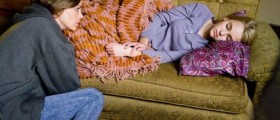
Sleepwalking can be very dangerous since the person affected by it is not aware of his/her actions. Basically, sleepwalking involves walking while asleep, during the deepest phases of sleeping. This phenomenon usually affects children even though, if left untreated, it can affect adults too. People who sleepwalk do not remember their actions during their night “strolls”.
Why Do People Sleepwalk?
A specific part of our brain is in charge for both sleeping and waking up. Thus, when we fall asleep, a special blockage prevents our brain from being busy and cuts off the messages for movement sent by the nerves. However, with sleepwalkers, this harmony is absent and, even though their brains fall asleep, their bodies remain awake. While some sleepwalkers stand next to their beds or walk around the room, some go a bit further and even leave the house, without being aware of this.
Reasons behind Sleepwalking
The first risk factor, when it comes to sleepwalking is genetics. Basically, if some member of your family was prone to sleepwalking, there are great chances that you will be too. Additionally, researches have shown that identical twins commonly share this phenomenon.
Secondly, an underlying condition may lead to sleepwalking. Most commonly, these are fever, arrhythmia, asthma, seizures and sleep apnea. Also, behavioral and psychiatric disorders such as multiple personality disorder, panic attacks and stress disorders may lead to sleepwalking.
Finally, environmental factors such as stress, alcohol abuse, sleep deprivation or sleep disorders, drugs and sedatives as well as antihistamines can trigger sleepwalking as a side-effect.
Treating Sleepwalking
In most cases, children who sleepwalk stop doing this once they get older. However, preventing these manifestations is recommended.
For preventive purposes, make sure that the sleepwalker’s room is on the ground floor with all the windows closed tight and all potentially dangerous objects removed. Also, make sure that the sleepwalker has a constant and regular sleeping schedule, thereby ruling out any chances of sleep deprivation. Additionally, advise the sleepwalker to go to the bathroom before going to bed since, quite often, a full bladder triggers sleepwalking sessions.
Alternatively, you can tie a bell above the door of the sleepwalker’s room. This way you will know when he/she leaves the room and he/she might wake up once the sound is produced. Finally, if all else fails, hypnosis and medication therapies can help people overcome sleepwalking.
Keep in mind that, statistically, sleepwalking appearing before the age of 9 lasts approximately until the child’s 14th birthday. However, if the child starts sleepwalking after the age of 9, there are great chances that this disorder will remain prevalent throughout adulthood. Also, boys are more prone to this phenomenon than girls.

















Your thoughts on this
Loading...